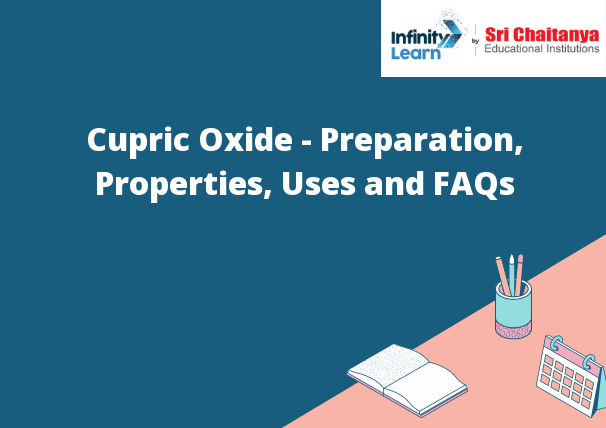Table of Contents
What is Cupric Oxide ?
Cupric Oxide – Preparation: Cupric oxide is a chemical compound with the formula CuO. It is a black solid that is slightly soluble in water. Cupric oxide is an important pigment and is used in the manufacture of ceramics, enamels, and inks. Cupric oxide is an inorganic compound with the chemical formula CuO. It is a black solid that is insoluble in water. Cupric oxide is produced by the oxidation of copper metal. It is used as a pigment and as a catalyst in the production of sulfuric acid.

Cupric Oxide and Cuprous Oxide
- Cupric oxide is a compound with the formula CuO. It is an oxide of copper. Cuprous oxide is a compound with the formula Cu2O. It is an oxide of copper.
- Cupric oxide and cuprous oxide are both copper oxides. Cupric oxide is CuO, while cuprous oxide is Cu2O. Cupric oxide is a black solid, while cuprous oxide is a red solid. Both cupric oxide and cuprous oxide are insoluble in water.
- Cupric oxide is the more stable of the two copper oxides. Cuprous oxide is more reactive and will slowly convert to cupric oxide in the presence of air. Cupric oxide is used to make copper salts, while cuprous oxide is used to make copper alloys.
Preparation of Cupric Oxide and Cuprous Oxide
Cupric oxide is prepared by the oxidation of copper metal with oxygen gas:
Cu(s) + O2(g) → CuO(s)
Cuprous oxide is prepared by the oxidation of copper metal with hydrogen peroxide:
Cu(s) + H2O2(aq) → Cu2O(s)
- Preparation of cupric oxide and cuprous oxide can be done by different methods. In this experiment, the copper will be dissolved in sulfuric acid to form copper sulfate. The copper sulfate will then be heated to form copper oxide and sulfur dioxide. The copper oxide will then be heated to form cuprous oxide and sulfur dioxide.
- The first step is to dissolve the copper in sulfuric acid. To do this, add 100 milliliters of sulfuric acid to a 250-milliliter Erlenmeyer flask. Then, add 0.5 grams of copper to the sulfuric acid. Swirl the flask to mix the ingredients.
- The next step is to heat the copper sulfate. To do this, place the flask in a hot water bath and heat it to boiling. Boil the mixture for about 10 minutes.
- The next step is to filter the mixture. To do this, place a Buchner funnel on a 250-milliliter Erlenmeyer flask. Then, place a filter paper in the funnel. Pour the mixture from the Erlenmeyer flask into the Buchner funnel. Let the mixture cool.
- The next step is to heat the copper oxide. To do this, place the flask in a hot water bath and heat it to boiling. Boil the mixture for about 10 minutes.
- The next step is to filter the mixture. To do this, place a Buchner funnel on a 250-milliliter Erlenmeyer flask. Then, place a filter paper in the funnel. Pour the mixture from the Erlenmeyer flask into the Buchner funnel. Let the mixture cool.
- The next step is to heat the cuprous oxide. To do this, place the flask in a hot water bath and heat it to boiling. Boil the mixture for about 10 minutes.
- The next step is to filter the mixture. To do this, place a Buchner funnel on a 250-milliliter Erlenmeyer flask. Then, place a filter paper in the funnel. Pour the mixture from the Erlenmeyer flask into the Buchner funnel. Let the mixture cool.
Physical Properties of Cupric Oxide
- Cupric oxide is a blue-green solid that is insoluble in water. It is a good conductor of electricity and is used in electrical wiring. Cupric oxide is also used as a pigment in paints and other products.
- Cupric oxide is a compound with the chemical formula CuO. It is a black, solid material that is insoluble in water. Cupric oxide is a good conductor of electricity. It is used in the manufacture of electronic devices and in the production of ceramics.
- Cupric oxide is a reddish-orange powder that is insoluble in water. It is a good conductor of electricity and is used in batteries and other electrical applications. Cupric oxide is also used as a pigment in paints and other products.
Chemical Properties of Cupric Oxide
- Cupric oxide is a red-brown powder that is insoluble in water. It is a strong oxidizing agent and reacts with most metals to form cuprous or cupric salts.
- CuO is a dark blue solid with a density of 6.0 g/cm3. It is insoluble in water but soluble in acids. It is a strong oxidizing agent and reacts with most metals to form cupric salts.
- CuO is a good conductor of electricity and is used in electrical wiring. It is also used as a pigment in paints and inks.
Uses of Cupric Oxide
- Cupric oxide is used as a pigment in ceramic glazes and paints. It is also used as a catalyst in organic synthesis, as a wood preservative, and in the production of other copper compounds.
- Cupric oxide is a compound of copper and oxygen with the chemical formula CuO. It is a black solid with a metallic luster. Cupric oxide is produced by the reaction of copper and oxygen in an oxygen-rich environment. It is used in the production of copper alloys, as a pigment, and as a catalyst.
- Cupric oxide is used in the production of copper alloys. It is a component of brass, a copper-zinc alloy, and bronzes, a copper-tin alloy. It is also used to produce cupronickel, a copper-nickel alloy.
- Cupric oxide is also used as a pigment. It is used to produce a green pigment called copper acetate green.
- Cupric oxide is also used as a catalyst. It is used to produce hydrogen peroxide and other oxygen-containing compounds.








